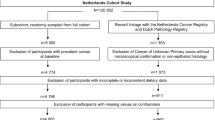Abstract
Objective: We have examined the role of dietary patterns and specific dietary nutrients in the etiology of lung cancer among non-smokers using a multicenter case–control study.
Methods: 506 non-smoking incident lung cancer cases were identified in the eight centers along with 1045 non-smoking controls. Dietary habits were assessed using a quantitative food-frequency questionnaire administered by personal interview. Based on this information, measures of total carotenoids, beta-carotene and retinol nutrient intake were estimated.
Results: Protective effects against lung cancer were observed for high consumption of tomatoes, (odds ratio (OR) = 0.5; 95% confidence interval (CI) 0.4–0.6), lettuce (OR = 0.6; 95% CI 0.3–1.2), carrots (OR = 0.8; 95% CI 0.5–1.1), margarine (OR = 0.7; 95% CI 0.5–0.8) and cheese (OR = 0.7; 95% CI 0.5–1.0). Only weak protective effects were observed for high consumption of all carotenoids (OR = 0.8; 95% CI 0.6–1.0), beta-carotene (OR=0.8; 95% CI 0.6–1.1) and retinol (OR = 0.9; 95% CI 0.7–1.1). Protective effects for high levels of fruit consumption were restricted to squamous cell carcinoma (OR = 0.7; 95% CI 0.4–1.2) and small cell carcinoma (OR = 0.7; 95% CI 0.4–1.2), and were not apparent for adenocarcinoma (OR = 0.9; 95% CI 0.6–1.3). Similarly, any excess risk associated with meat, butter and egg consumption was restricted to squamous and small cell carcinomas, but was not detected for adenocarcinomas.
Conclusions: This evidence suggests that the public health significance of increasing vegetable consumption among the bottom third of the population would include a reduction in the incidence of lung cancer among lifetime non-smokers by at least 25%, and possibly more. A similar protective effect for increased fruit consumption may be present for squamous cell and small cell lung carcinomas.
Similar content being viewed by others
References
Parkin DM, Sasco AJ (1993) Lung cancer: worldwide variation in occurrence and proportion attributable to tobacco use. Lung Cancer 9: 1–16.
Pisani P, Parkin DM, Muñoz N, et al. (1997) Cancer and infection: estimates of the attributable fraction in 1990. Cancer Epidemiol Biomarkers Prev 6: 387–400.
World Cancer Research Fund (1997) Food, Nutrition and the Prevention of Cancer: a Global Perspective. Washington, DC: American Institute for Cancer Research.
IARC (1998) Carotenoids. IARC Handbooks of Cancer Prevention, Vol. 2. Lyon: International Agency for Research on Cancer.
Boffetta P, Agudo A, Ahrens W, et al. (1998) Multicenter case-control study of exposure to environmental tobacco smoke and lung cancer in Europe. J Natl Cancer Inst 90: 1440–1450.
Mangels AR, Holden JM, Beecher GR, et al. (1993) Carotenoid content of fruits and vegetables: an evaluation of analytic data. J Am Diet Assoc 93: 284–296.
McCance RA, Widdowson EM (1985) The Composition of Foods (MRC Special Report No. 297). Fourth revised and extended edition. London: Her Majesty's Stationery Office.
White H (1982) Maximum likelihood estimation of mis-specified models. Econometrica 50: 1–25.
Nyberg F, Agrenius V, Svartengren K, et al. (1998) Dietary factors and risk of lung cancer in never-smokers. Int J Cancer, 78: 430–436.
Jöckel K-H, Pohlabeln H, Ahrens W, et al. (1998) Environmental tobacco smoke and lung cancer. Epidemiology 9: 672–675.
Armstrong BK, White E, Saracci R (1992) Principles of Exposure Measurement in Epidemiology. New York: Oxford University Press.
Nyberg F, Agudo A, Boffetta P, et al. (1998) A European validation study of smoking and environmental tobacco smoke exposure in nonsmoking lung cancer cases and controls. Cancer Causes Control 9: 173–182.
Brownson RC, Alavanja MCR, Caporaso N, Simoes EJ, Chang JC (1998) Epidemiology and prevention of lung cancer in nonsmokers. Epidemiol Rev 20: 218–236.
Peto R, Doll R, Buckley JD, et al. (1981) Can dietary beta-carotene materially reduce human cancer rates? Nature 290: 201–208.
Omenn GS, Goodman GE, Thornquist MD, et al. (1996) Effects of combination of beta-carotene and vitamin A on lung cancer and cardiovascular disease. N Engl J Med 334: 1150–1155.
Hennekens CH, Buring JE, Manson JE, et al. (1996) Lack of effect of long-term supplementation with beta carotene on the incidence of malignant neoplasms and cardiovascular disease. N Engl J Med 334: 1145–1149.
The Alpha-Tocopherol Beta Carotene Cancer Prevention Study Group (1994) The effect of vitamin E and beta carotene on the incidence of lung cancer and other cancers in male smokers. N Engl J Med 330: 1029.
Mayne ST, Janerich DT, Greenwald P, et al. (1994) Dietary beta carotene and lung cancer risk in U.S. nonsmokers. J Natl Cancer Inst 86: 33–38.
Steinmetz KA, Potter JD (1991) Vegetables, fruit, and cancer. II. Mechanisms. Cancer Causes Control 2: 427–442.
IARC (1998) Vitamin A. IARC Handbooks of Cancer Prevention, Vol. 3. Lyon: International Agency for Research on Cancer.
Alavanja MCR, Brown CC, Swanson C, et al. (1993) Saturated fat intake and lung cancer risk among nonsmoking women in Missouri. J Natl Cancer Inst 85: 1906–1916.
Swanson CA, Brown CC, Brownson RC, et al. (1997) Re: saturated fat intake and lung cancer risk among nonsmoking women in Missouri. J Natl Cancer Inst 89: 1724–1725.
Swanson CA, Brown CC, Sinha R, et al. (1997) Dietary fats and lung cancer risk among women: the Missouri Women's Health Study (United States). Cancer Causes Control 8: 883–893.
Sinha R, Kulldor. M, Curtin J, et al. (1998) Fried, well-done red meat and risk of lung cancer in women. Cancer Causes Control 9: 621–630.
Author information
Authors and Affiliations
Rights and permissions
About this article
Cite this article
Brennan, P., Fortes, C., Butler, J. et al. A multicenter case–control study of diet and lung cancer among non-smokers. Cancer Causes Control 11, 49–58 (2000). https://doi.org/10.1023/A:1008909519435
Issue Date:
DOI: https://doi.org/10.1023/A:1008909519435




